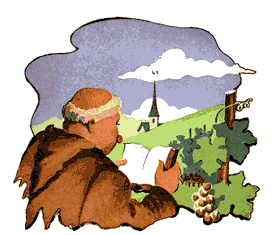Wine
glossary


Acidity :
All wines contain acids. Acidity is the structure of white
wines. Acidity gives to the wine body and taste.
Alcohol :
The alcohol in wine is called ethyl alcohol. It is the result
of the transformation of sugars due to the action of yeasts
in the grapes. About 20 grams of sugar are needed to obtain
1° (one degree) of alcohol. Alcohol
is the base of wine, it is a powerful preservative. Alcohol,
such as tannins, allows the wine to age. But the taste of
alcohol must not in any case dominate the wine. Visit "Composition
of wine"
Alcoholic
degree :
Since 1980, the alcoholic degree is the percentage of alcohol
in the total wine volume. A wine labeled as 12° means
that alcohol counts for 12% of the volume (or 90 milliliters
of alcohol per bottle of wine)
Alcoholic
fermentation :
Transformation of sugar into alcohol and carbonic gas.
Visit
"Winemaking"
AOC :
Stand for Appellation d'Origine Controlée and a suggested
translation would be "regulated wine of origin".
AOC is the higher nationwide wine grade. Visit "AOC
in Wine Grades".
Aromas :
Wines have "arome de bouche" (in the mouth aromas),
all the same these are not available with different tastes
which could be chosen from a mention on the label. There
exist fruity wines, earthy wines (taste of mushroom, under
wood, dried-leaves), spicy wines (aromas of
cinnamon, clove, pepper, Indian spices) wines with aromas
of herbs (mint, hay, rosemary, Provence herbs ...). Visit "Aromas
and Wine".
Assemblage :
Assemblage is the blending of several wines, generally issued
from different grape-varieties, independently
vinified. Most of the time, assemblage wines are disappointing.
Visit "Winemaking".

Balance :
Indicates the proportion between these four components :
alcohol, acidity, sugar and dry extract. A wine is well-balanced
when none of those characteristics dominates; the balance
is harmonious. The general balance means the proportion of
smooth and harsh in the wine.
Body :
It is the global impression of a wine. Wines are lightly
bodied, medium bodied, full bodied depending on its thickness.
Visit "Tasting advices".
Bouquet :
Includes all the different smells of a wine. Aroma is
more for young wines while bouquet applies to matured wines.

Cordial
wines :
They are pleasant wines, with no salient features, easy
to drink for anybody.
Cru
bourgeois :
A wine grade in the Bordeaux region.
Between Grands Crus Classés and AOC. New law as
of June 2003, Visit the "The
classification of cru bourgeois".
Cru
classé
(Great Growth) :
Classification of quality Bordeaux produced
in Chateaux and Estates. Grands Crus Classés ranking
from 1st to 5th grade are the best of the best! Visit "Crus
classés (Great growths)".

Decanting :
Is the action of pouring a wines directly from its bottle
in a jug, in order to separate the wine from its sediment,
to provide oxygen and to release its aromas.
Devatting :
Transferring the (red) wine from
the fermentation tank after the alcoholic fermentation into
an other tank, leaving the pomace and what solid have been
pressed in the emptied tank. Also called s the free run wine.
Visit "Winemaking".
Destemming :
Nowadays mechanical.
Dry : White
wine containing little sugar (1 to 9 grams per liter).

Fat
wines :
Sweet and soft it is called flat and disliked. It is qualified
of voluptuous when judged excellent.

Generous
wines :
Full and rich wines which easily deliver their flavour.
Visit "Tasting advices".
Grafting :
Process of reproduction of the plant, by grafting a branch
on a selected root stock in order to favour the development
of solid vine stock.

Lees :
Lees are the solid element which precipitates at the end
of the fermentation; cells of dead yeast, pulp of berries
and, in red wines, pips and grape-skin.
Length :
Neither centimeter, nor inches! the length of a wine are
the feeling you get from it along your palate. A long wine
can be tasted on every tasting territories of the tongue.
The length of a wine is an absolute sign of its quality.
Visit "Tasting advices".

Malolactic
fermentation :
Transformation of the malic acid in lactic acid. Visit "Winemaking".
Must :
Fermenting grape juice.

Phylloxera :
Vine disease due to a small green-fly. At the end of the
19th century, coming from America, the Phylloxera destroyed
the 3/4 of the French vineyard. Grafting saved French vines.
Pomace :
The pomace is the residue of the harvest. It contains stems,
skin and pips. It can be distilled to obtain Raw brandy.
Primeur
(New wine) :
Wine elaborated quickly. Primeur can come out of the winery
as soon as the 15th of november. Visit "Beaujolais".

Raking :
Separating grape juice from solid elements, before fermentation
(white wine). Separating wine from
pomace (red wine).
Ripeness :
It is exceptional when a vine grower manages to harvest when
all his grapes are perfectly mature. Perfect ripeness is
quiet unusual.
Robe :
The robe is the colour of the wine.


Tannin :
Tannin is a substance naturally present in the skin and other
parts of the grapes. Tannin is, to red
wine what acidity is to white wine, its structure. Tannin
(bitter) is detected by the back of the tongue. Depending
on the amount the wine is bitter, supple or firm. Certain
wines leave an impression of suppleness or smoothness others
an impression of harshness or firmness.

VDQS :
Vin délimité de qualité supérieure.
Visit "The classification of wine
in France".
Vinegar :
The natural evolution of the juice of grape, vine is only
a way towards vinegar. Any wine might become vinegar. Visit "Vinegar".
Vintage :
Year of vinification.

Wine
coop / Vinegrowers' cooperative :
Cellar run in common by a group of vine growers. Over a
1 000 coop vinify about 30% of French production.
Winery :
Wine is made there!

Yeast :
Unicellular micro-organism (fungus) naturally present on
the skin of grapes. It provokes alcoholic fermentation and
is indispensable in the elaboration of wine. Visit "winemaking".
|




